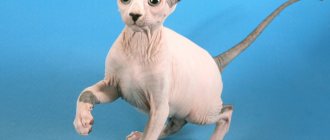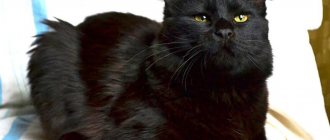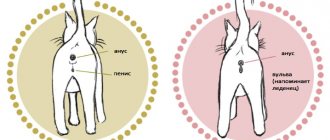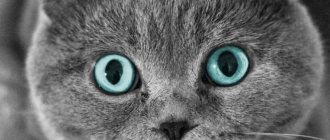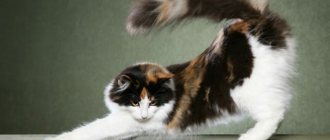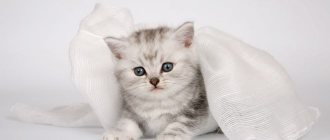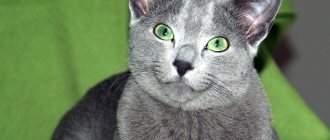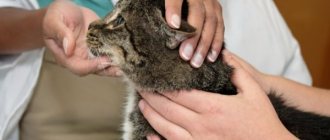The Ragdoll cat is affectionate and pliable. In addition, she is known for her lazy, phlegmatic character. By competing on these qualities, she can collect all the cups and medals in international competitions. For some people, this is an absolute flaw, but for others, it is a charming character trait.
What is the difference between Sacred Burma and Neva Masquerade
296 messages
To feel the difference, it is better to see representatives of both breeds. This is possible at the exhibition. In Sacred Burma, the Siamese color (color-point) has been fixed for many generations. And in the Neva Masquerade breed, this color was obtained recently, in fact, like the breed itself. Because of this, the Neva Masquerade breed darkens its body more with age and practically does not have bright blue eyes; more often the eye color has a bluish-grayish or bluish-greenish tint. Whereas in the Sacred Burma you can observe the greatest contrast in color (bright points and light body) and bright eye color of a pure shade from bright blue to blue.
The quality of wool also varies greatly among these breeds. The Sacred Burma has a soft, silky coat that does not require regular grooming, while cats of the Neva Masquerade breed, like Siberian cats, have a harder coat, with a pronounced awn, and a large amount of undercoat. Representatives of the Neva Masquerade breed are heavier in bone structure. They are stronger and larger.
There is also a difference in color. The Sacred Burma's white “gloves” on its paws are determined by a gene that is not found in any other breed. These gloves have a specific pattern, which is described in detail in the standards. While in the Neva Masquerade breed, white on the paws is determined by a completely different gene - the white spotting gene and can have an arbitrary pattern, or be absent. Thanks to the same white spotting gene, cats of the Neva Masquerade breed can have white spots on their faces, which is completely unacceptable in the Sacred Burma. (c) www. mau. ru
Tatyana, I’m not Lena Kravets (who writes under her husband’s nickname), but I can answer as a professional who deals with cats in general and Burmese cats in particular.
In fact, the Neva Masquerade is a color-point Siberian, and accordingly, its character is Siberian: independent, but flexible. Siberians are an aboriginal Russian breed, so their character in our country is quite clear; many had (and still have) our ordinary fluffy cats in their home. In the early 90s, when Russia entered the world of felinology, our enthusiasts tried to get our Russian heritage - the Siberian cat - noticed and recognized as a breed. A standard was developed, and further breeding of Siberians began to gain momentum. However, Siberians still have a “breed determination” class, where (after small formalities) you can bring to the exhibition any cat that is phenotypically (outwardly) similar to a Siberian, and if two experts recognize it as meeting the Siberian standard, it will be issued documents confirming her breed.
The Burmese is a completely different breed, not only in appearance and feel, but also in character. They have been culturally bred by people for a long time. Even if we do not take into account the legend (according to which these cats have lived in the monasteries of Burma since time immemorial), then only the European history of the Burma has been officially maintained since 1919, the standard was adopted in France in 1925, and in 1926 the Burma was first shown on exhibition in Paris. Therefore, the Burmese character is very “humanized”; they suffer a lot without people, but at the same time they are very delicate and do not impose themselves. Burms are friendly, smart, highly intelligent, get along easily with other animals and never offend children. And another feature of the Burmese character is devotion to their beloved owner; the Burmese does not care where to live, as long as the beloved owner is nearby.
In general, to understand the breed, photographs alone are not enough; you must see the cats in person. This can always be done at cat shows. If you manage to communicate well with the owners of the breeds you like, you can even persuade them to let you touch their cats. Then the difference between the wool of a Siberian and a Burmese will be completely obvious. The only catch is that there are a lot of Siberians (including Nevaks), they can be seen at a large number of exhibitions, but there are few Burmas (that’s why I always write in announcements in the group where the nearest exhibition will be held where you can see Burmas).
And I can say more. A person who gets a Burmese never switches to another breed. To understand what real Burma is, you have to live with it.
Source
Description of the Burmese breed and standards
The Burmese breed has distinctive features - white paws, pink pads, and wide-set blue eyes.
Head and muzzle
Burmese cats have a triangular head shape, the contour of which gradually becomes rounded. The zygomatic bone is located high, the frontal part protrudes forward. Cats have a fairly large nose. The ears are small in size with rounded tips. The Burmese's eyes are wide-set and almond-shaped.
Frame
This breed is characterized by medium body size and well-developed muscles. The limbs are low, ending in wide paws. The tail is usually short.
Coat
Burmese cats have a medium-length coat with short undercoat. On the head it lengthens towards the cheeks, after which it turns into a fairly thick fur collar. The tail is distinguished by thick, long hair. The longest hair is on the side of the body and back.
Colors
Burmese cats have a characteristic color - the body has a smooth white color, turning into a dark color closer to the forelimbs, and white “gloves” and “socks” are required. The fur on the face is dark in color and extends to the ears. The tail part is painted dark. The pads most often have a pink tint and may have spots.
The color of Burmese cats is very diverse, a combination is possible:
- brown markings on a background of beige fur;
- chocolate color with ivory;
- blue shadows against a background of light blue wool.
Thai and Siamese cats: character and features
Thai-type cats have been known since the 14th century, and about a hundred years ago, the breed now known as the Siamese was developed from them. At the same time, the “original” version of the Thai cat almost disappeared. The breed was preserved, and its standard was approved in 1990. Thai (or Old Siamese) and Siamese cats are close relatives and non-specialists often confuse them. During selection, the Siamese received a narrower, wedge-shaped head with large ears and long paws. "Thais", on the contrary, have more traditional proportions and a round head, for which they are informally nicknamed "apple-headed".
The weight of Thai and Siamese cats can range from 3 to 6 kg, while Siamese cats are thinner and more graceful, while Thai cats have a denser build.
A curious and active breed. It is worth thinking in advance where these cats will spend a huge amount of their energy. As an option, Thai and Siamese cats can be trained to walk on a leash.
Sociable and talkative, these cats usually choose their “favorite” family member. “Thais” and “Siamese” love physical contact, but are unlikely to sit on your lap for hours; they would rather rest on their legs or arms when you are not moving.
Overall, this is a healthy breed with a slight tendency to overeat. Sometimes there are problems with teeth, so it is advisable to monitor your oral health and get used to brushing your teeth from a young age.
These cats should also be protected from drafts. Hereditary diseases are rare and, as a rule, occur in non-purebred cats.
Get along with animals and children
Loves company. He tolerates noisy children's games well, gets along easily with dogs (sometimes the “Thai” even begins to behave like a dog and protect the apartment from strangers).
Feeding recommendations
What to feed a Thai and Siamese cat:
As a rule, Thais and Siamese are active cats, so it is better to choose food that is high in protein. Will fit GO! , Farmina , Grandorf , Applaws . Given the tendency to overeat, it is better to choose food with a low fat content.
Interesting fact: Thais and Siamese are so-called “colored cats”. Their color depends on many factors, such as the temperature in the house or what they eat. The darkest places are the ears, paws and tail and are also the coldest. And kittens are born completely white, and begin to darken only by the end of the second week.
Our conclusion: Cheerful and social, Thai and Siamese cats will do well in a large family, especially if they are played with a lot. And don't forget about the nets on the windows! If you dream of a “cushion cat” that will lie on the sofa all day, it is better to choose a different breed.
Cat breeds similar to the Siamese in body shape
Of course, when many people hear the phrase “Siamese cat,” they first associate it with its characteristic color. However, the physique of these beauties also deserves attention. After all, they are graceful, elongated and flexible.
Often the breed can be recognized by its appearance, and there are a number of them that are very reminiscent of Siamese cats in this regard.
Oriental
Orientals are notable for their long bodies and huge ears. Sometimes because of them, these cats are even called “goblins,” and their expressive green eyes complement this impression.
Orientals are quite large cats. Their weight can reach 5-8 kilograms. Their fur can be both short and long.
The character of Oriental cats deserves special mention. They are sociable, prefer company to loneliness and extremely love to “talk”.
Important! This breed is not suitable for busy people.
Seychelles
Seychelles cats are descended from Orientals and Siamese. They are quite rare, but nevertheless deserve mention. The fact is that Seychellois are typical cats in the stereotypical sense.
They walk on their own, do not particularly need a family, although they are capable of experiencing tender feelings for a specific person.
They share large ears, an elegant and muscular physique, and blue eyes with their ancestors. The hair of Seychelles cats can be either short or long.
Important! Seychelles do not like change of environment, intrusive attention and do not get along very well with other animals in the house.
Neva Masquerade cat: care and character traits
This is a fairly young breed, which received an official standard only in the 90s of the 20th century. The exact place of origin of the breed is unknown; genetically, the Neva Masquerade cat is closest to the Siberian breed.
Large cats, a cat's weight can reach 9 kg, a cat's weight is usually 5-6 kg.
Cheerful and active cats. This is a "vertical" rock, so make sure there are climbing areas.
They become strongly attached to their owner. At the same time, you can be calm about the furniture and curtains: the Neva masquerade cat will not behave destructively when alone.
Like other native breeds, Newakis are generally healthy. Cases of cardiomyopathy have been recorded, so periodic ultrasound of the heart would be useful.
The beautiful long coat requires special care; it must be combed regularly with a furminator or a regular comb.
Get along with animals and children
These cats get along easily with dogs and are loyal to small children... to a certain extent. Nevaks do not tolerate familiarity, for which they are sometimes called aristocrats in the cat world.
Feeding recommendations
What to feed the Neva masquerade cat:
The Neva Masquerade, like the Siberian cat, is an unpretentious breed in food. When choosing food, we recommend paying attention to high-quality food from the holistic category. Feeds with large granules ( Farmina , Savarra , Applaws ) are better suited. For feeding active pets, it is better to choose food with a high protein content: Applaws , GO!
To prevent the formation of hairballs, it is periodically recommended to buy special food for hair removal.
Interesting fact: Although it is believed that Neva masquerade cats are genetically closer to Siberian cats, their color, namely color-point and eye color, is a legacy of Siamese ancestors.
Our conclusion: The Neva Masquerade cat will feel great even in a small apartment. The main thing is to have your own space for games and relaxation. Please note that Nevaks are very wary of strangers (especially if they do not keep their distance).
Diseases and life expectancy
Burmese cats live on average from 10 to 15 years, there are also long-livers, over 20 years. This breed has a congenital predisposition to certain diseases:
- Hypertrophic cardiomyopathy - occurs as a result of inheritance of the disease in an autosomal dominant manner. It is characterized by myocardial damage with the gradual formation of heart failure, thrombus formation and, as a result, death.
- Kidney disease - the most commonly diagnosed disease is urolithiasis.
- Spongiform encephalopathy is a degenerative change in the substance of the brain, in which neurological pathologies are observed, paresis and paralysis of the limbs are possible.
- Corneal dermoid is a tumor that occurs as a result of impaired tissue embryogenesis. The disease manifests itself at a young age, with a tumor forming on the mucous membrane of the eyes, which looks similar to the skin. It can be treated through surgery and does not pose a danger to the animal if promptly contacted by a specialist.
Cornish Rex: features of the breed
Cats of this breed are unusual, at least in terms of the structure of their fur, which consists of a single undercoat, and curly one at that. It is the result of a naturally occurring genetic mutation first discovered in 1950 in a barn cat from Cornwall, UK.
Graceful and petite. Cats weigh up to 3 kg, males - a maximum of 4.5 kg.
The Cornish Rex is an active, but at the same time exclusively domestic breed. Be prepared for the Cornish to poke his nose into all your household affairs.
These cats are natural companions who devotedly love their owners. Cornish Rex cats get bored when alone.
The Cornish's curly coat does not need to be combed; brushing with a silicone brush is sufficient. Cornish Rex dogs are prone to overeating and do not like the cold.
Get along with animals and children
The Cornish Rex will get along well with children and other pets, as these cats ALWAYS need play partners and conversation partners. And if the dog is too annoying, the Cornish will simply jump onto the cabinet.
Feeding recommendations
For the Cornish Rex, we recommend choosing food with medium-sized granules, but with a high meat content. We advise you to pay attention to Grandorf , GO! , NOW .
Interesting fact: The breed’s coat is its calling card. But at the same time, some wool imperfections are allowed for up to a year. The main condition is that the coat must meet the standards by the year.
Our conclusion: The Cornish is ready to communicate with his owner 24 hours a day, so he can become an ideal life partner for a lonely elderly person. This cat will be comfortable in a small apartment. Some doctors note that Cornish Rex cats are less likely than other breeds to cause reactions in allergy sufferers.
Source
Advantages and disadvantages
Among the advantages of the Burmese breed, one can emphasize a calm, affectionate character, a friendly attitude towards both adults and children, unpretentiousness when caring for the coat, quick habituation to the tray, a balanced temperament, and loving nature.
But this breed also has some disadvantages, these are, first of all, the high cost of kittens, in addition, they need special nutrition, and they also do not tolerate loud noises well. Burmese cannot remain alone for a long time, so they require a lot of attention from their owners.
Standard WCF values for SIB breed
It is of medium size or powerful, large, muscular. The limbs are medium in height and create a rectangular shape with the body. The neck is short and strong, the chest appears wide, the tail is longer than average, with soft undercoat. The paws are round and massive. Despite the “powerful indicators”, the body is quite graceful.
Trapezoidal, massive, in proportion to the body. Wide, slightly rounded forehead. The nose is slightly deep and medium in size. Massive but not protruding chin, well developed jaws.
Medium-sized, spaced quite widely. Slightly inclined forward, rounded at the end with tassels at the ends.
Most often large, round in shape, with a wide fit. Eye color is clear, uniform, and can vary from dark to bright blue.
Small but strong.
Large, wider at the base, fluffy, length to the shoulder blades, rounded at the end.
Moderately long, glossy, smooth, waterproof, with a soft, dense undercoat covered with coarser hair on top. The hair on the chest, neck and paws is longer, and the hair on the back is shorter. The undercoat is denser in cold weather, and thinner in warmer periods.
The Neva Masquerade cat comes in several color options: seal point, blue point, red point, tortoise point. They all have the "Tebby" variety. White points are also allowed.
